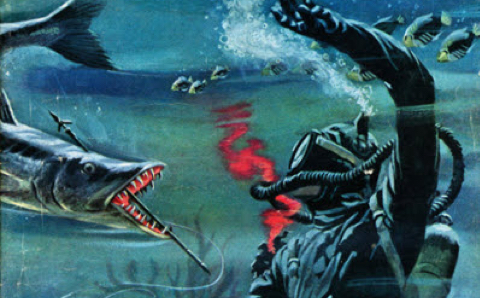 ARGOSY . . . ADVENTURE . . . BLUE BOOK . . . when it comes to pulps, these three magazines were the “aristocrats.”
ARGOSY . . . ADVENTURE . . . BLUE BOOK . . . when it comes to pulps, these three magazines were the “aristocrats.”
THE ARGOSY was the first pulp magazine, having been converted to an all-fiction magazine with its October 1896 issue. Two months later, publisher Frank Munsey began to print it on wood-pulp paper. The rough-paper fiction magazine — or pulp — was born.
When THE ARGOSY celebrated its 25th anniversary in 1907, its circulation had reached a half million copies. Given its success, THE ARGOSY was bound to attract imitators. Street & Smith, longtime publisher of dime novels and story papers, was first to meet the call. It debuted THE POPULAR MAGAZINE in late 1903. Munsey countered in 1904 with its second pulp, THE ALL-STORY. One year later, the Story-Press Corporation introduced THE MONTHLY STORY MAGAZINE. Not long thereafter, it became THE MONTHLY STORY BLUE BOOK MAGAZINE. In late 1910, the Ridgway Company introduced the pulp known as ADVENTURE.
These five periodicals — along with SHORT STORIES — led the pulp magazine industry for decades, publishing some of the field’s best writers: H Bedford-Jones, Max Brand, Edgar Rice Burroughs, Agatha Christie, Zane Grey, H. Rider Haggard, James B. Hendryx, Harold Lamb, A. Merritt, Clarence Mulford, Talbot Mundy, E. Phillips Oppenheim, Sax Rohmer, Rafael Sabatini, Edgar Wallace, and others. They also introduced the world to Tarzan, Zorro, Barsoom, Hopalong Cassidy, Captain Blood, and Pellucidar.
The stresses of World War II — the loss of writers and artists to the war effort, paper shortages, declining readerships, changing tastes — generated a slow but steady metamorphosis of the “aristocrats.” ARGOSY was the first to change.
In 1943, ARGOSY was converted to a bedsheet, semi-slick magazine. Although fiction stories by top pulp writers remained a mainstay of the magazine, true war stories became more common, as did other true or fact-based stories. In the early fifties, ADVENTURE and BLUE BOOK followed suit.
 With the contraction of the pulp industry during the 1950’s, men’s adventure magazines began to take off. The successful transformations of ARGOSY, ADVENTURE, and BLUEBOOK (as it was renamed in 1952) brought about a significant increase of men’s adventure magazine titles. Although many were short-lived, more than 150 men’s adventure magazines were launched during the decade, thanks to the three “aristocrats.”
With the contraction of the pulp industry during the 1950’s, men’s adventure magazines began to take off. The successful transformations of ARGOSY, ADVENTURE, and BLUEBOOK (as it was renamed in 1952) brought about a significant increase of men’s adventure magazine titles. Although many were short-lived, more than 150 men’s adventure magazines were launched during the decade, thanks to the three “aristocrats.”
Join PulpFest 2019 on Friday, August 16, as we welcome Bob Deis and Wyatt Doyle for “ARGOSY, ADVENTURE and BLUE BOOK — Men’s Adventure Pulps,” a look at the metamorphosis of these “pulp giants” into men’s adventure magazines.
PulpFest 2019 will begin on Thursday, August 15, and run through Sunday, August 18. Join PulpFest at the DoubleTree by Hilton Hotel Pittsburgh – Cranberry, just north of Pennsylvania’s “Steel City” of Pittsburgh. To join PulpFest 2019, click the Register button below our homepage banner. To book a room at the DoubleTree by Hilton — our host hotel — click the Book a Room button, also found on our homepage.
(Bob Deis has worked as a teacher, an artist, a musician, a logger, a magazine writer, and a state government bureaucrat. By accident, he fell into a lengthy career as a political consultant. Now retired, Bob spends much of his time collecting, writing, and publishing books about the men’s adventure magazines, including the November 1957 issue of ADVENTURE, featuring cover art by Mort Künstler (as Emmett Kaye) and the May 1954 issue of BLUEBOOK, featuring cover art by John Walter. In 2009, Bob created the popular website about the genre, MensPulpMags.com. Several years later he became friends with another fan of the men’s adventure genre, writer and publisher Wyatt Doyle, co-founder of the New Texture imprint.
Together, Bob and Wyatt co-edit and publish the Men’s Adventure Library series of books that collect classic stories and artwork from the men’s adventure magazines. Their books include WEASELS RIPPED MY FLESH!, HE-MEN, BAG MEN, & NYMPHOS, CRYPTOZOOLOGY ANTHOLOGY, A HANDFUL OF HELL, BARBARIANS ON BIKES, I WATCHED THEM EAT ME ALIVE, POLLEN’S ACTION: THE ART OF SAMSON POLLEN, and POLLEN’S WOMEN: THE ART OF SAMSON POLLEN.)







